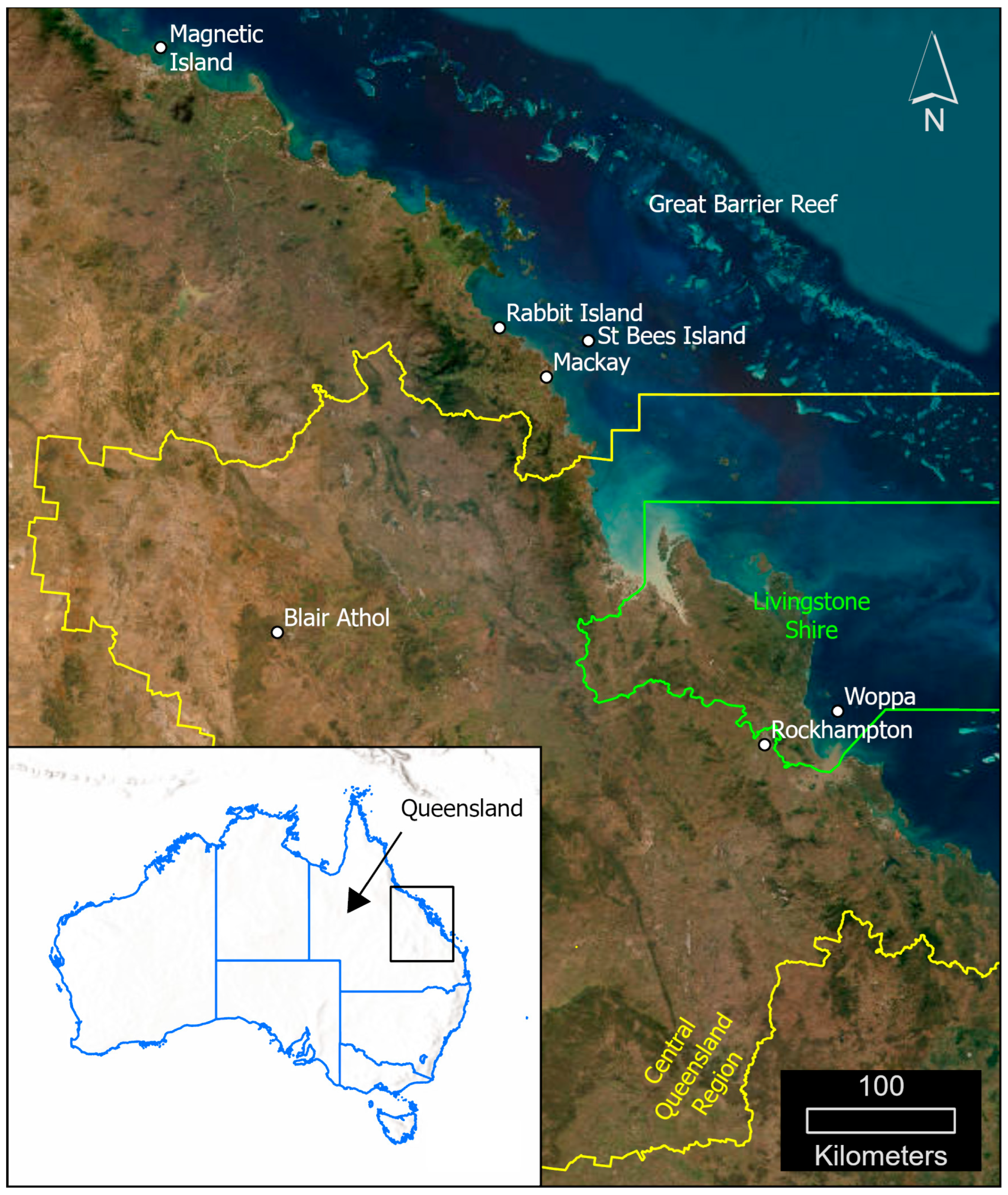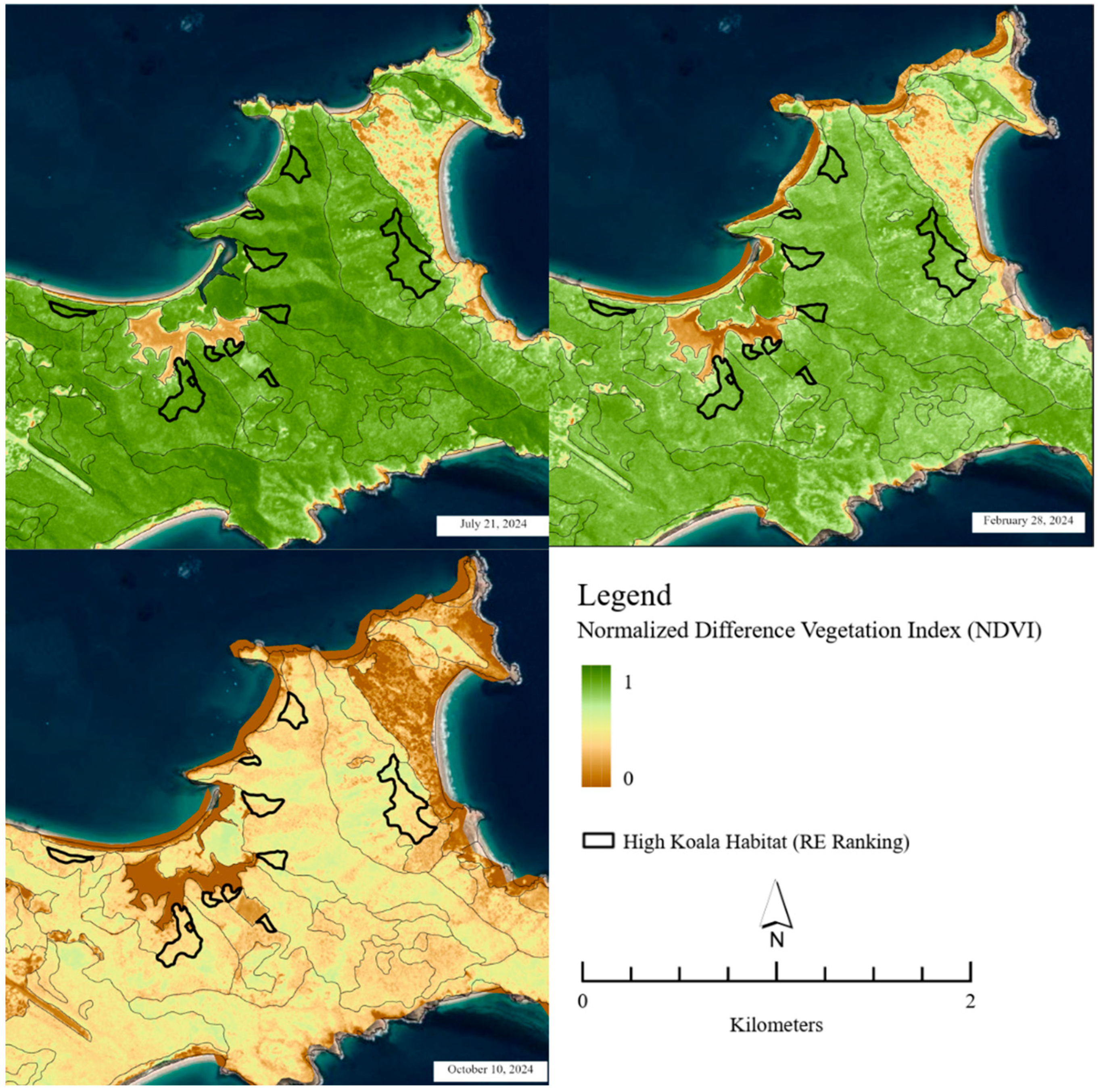Identifying and Mapping Prospective Koala Habitat on Woppa (Great Keppel Island), Queensland, to Explore Future Conservation Opportunities
Abstract
1. Introduction
2. Materials and Methods
2.1. Habitat Ranking Assessment
2.2. Koala Utility Tree Species on Woppa
2.3. Remote Sensing for Habitat Health Assessment
3. Results
3.1. Koala Habitat Ranking
3.2. Key Utility Tree Species in the Literature
3.3. NDVI and LAI Analysis
4. Discussion
5. Conclusions
Author Contributions
Funding
Institutional Review Board Statement
Informed Consent Statement
Data Availability Statement
Acknowledgments
Conflicts of Interest
Abbreviations
| NDVI | Normalised Difference Vegetation Index |
| LAI | Leaf Area Index |
| CQ | Central Queensland |
| RE | Regional Ecosystem |
| NESP | National Environmental Science Programme |
| BoM | Bureau of Meteorology |
References
- Department of Climate Change, Energy, the Environment, and Water: Koalas. Available online: https://www.dcceew.gov.au/environment/biodiversity/threatened/species/koalas (accessed on 22 August 2025).
- Danaher, M.; Shanks, D.; Jones, B.T.; Schlagloth, R. How Did They Get There? A History of Koalas on Queensland’s Islands. Aust. Zool. 2023, 43, 390–408. [Google Scholar] [CrossRef]
- Lee, K.E.; Seddon, J.M.; Johnston, S.; FitzGibbon, S.I.; Carrick, F.; Melzer, A.; Bercovitch, F.; Ellis, W. Genetic Diversity in Natural and Introduced Island Populations of Koalas in Queensland. Aust. J. Zool. 2013, 60, 303–310. [Google Scholar] [CrossRef]
- Eddie, M.J.; Ellis, W.A.; Kark, S. Koalas on Australian Islands. Biodivers. Conserv. 2025, 34, 3559–3587. [Google Scholar] [CrossRef]
- Stephen, P.; Callaghan, J. The Spot Assessment Technique: A Tool for Determining Localised Levels of Habitat Use by Koalas Phascolarctos Cinereus. Aust. Zool. 2011, 35, 774–780. [Google Scholar] [CrossRef]
- Callaghan, J.; McAlpine, C.; Mitchell, D.; Thompson, J.; Bowen, M.; Rhodes, J.; Jong, C.D.; Domalewski, R.; Scott, A. Ranking and Mapping Koala Habitat Quality for Conservation Planning on the Basis of Indirect Evidence of Tree-Species Use: A Case Study of Noosa Shire, South-Eastern Queensland. Wildl. Res. 2011, 2, 89–102. [Google Scholar] [CrossRef]
- Ellis, W.A.H.; Melzer, A.; Bercovitch, F.B. Spatiotemporal Dynamics of Habitat Use by Koalas: The Checkerboard Model. Behav. Ecol. Sociobiol. 2009, 63, 1181–1188. [Google Scholar] [CrossRef]
- Mitchell, D.L.; Soto-Berelov, M.; Langford, W.T.; Jones, S.D. Factors Confounding Koala Habitat Mapping at Multiple Decision-Making Scales. Ecol. Manag. Restor. 2021, 22, 171–182. [Google Scholar] [CrossRef]
- Melzer, A.; Vise, A. Mapping Central Queensland’s Koala Habitat Using Queensland’s Mapped Regional Ecosystems; Koala Research–CQ, Central Queensland University: Rockhampton, QLD, Australia, 2016. [Google Scholar]
- Raffini, F.; Bertorelle, G.; Biello, R.; D’Urso, G.; Russo, D.; Bosso, L. From Nucleotides to Satellite Imagery: Approaches to Identify and Manage the Invasive Pathogen Xylella Fastidiosa and Its Insect Vectors in Europe. Sustainability 2020, 12, 4508. [Google Scholar] [CrossRef]
- Song, F.; Wenyong, Z.; Tenggang, Y.; Zhenqing, J.; Zhiyu, C.; Baorong, X.; Lei, L.; Songbing, Z. Uav Quantitative Remote Sensing of Riparian Zone Vegetation for River and Lake Health Assessment: A Review. Remote Sens. 2024, 16, 3560. [Google Scholar] [CrossRef]
- Hewson, M.; Santamaria, F.; Melzer, A.; Melzer, R. Tools for Assessing Queensland’s Koala Habitat Condition; Koala Research CQ Central Queensland University: Rockhampton, QLD, Australia, 2019. [Google Scholar]
- Melzer, R.; Plumb, J. Plants of Capricornia, 1st ed.; Belgamba: Rockhampton, QLD, Australia, 2011; p. 22. [Google Scholar]
- Creighton, C. Keppel Islands Environmental Survey: A Baseline for Archaeological Reconstructions and Resource Management; Archaeology Branch, Department of Community Services: Brisbane, QLD, Australia, 1984. [Google Scholar]
- Morris, A.J. My Island in the Sun: An Early History of Great Keppel Island; A.J. Morris: Emu Park, QLD, Australia, 1989. [Google Scholar]
- Australian Museum: Woppaburra People of the Keppel Islands. Available online: https://australian.museum/learn/cultures/atsi-collection/woppaburra-people-of-the-keppel-islands/ (accessed on 2 September 2025).
- Woppaburra: Woppaburra Tumra. Available online: https://woppaburra.com.au/100-2/ (accessed on 2 September 2025).
- Australian Institute of Aboriginal and Torres Strait Islander Studies: Muir on Behalf of the Woppaburra People V State of Queensland. Available online: https://aiatsis.gov.au/ntpd-resource/2206 (accessed on 2 September 2025).
- Runge, C.; Rhodes, J.; Lopez-Cubillos, D.S. Mapping Koala Habitat for Greater Queensland Report; NESP Threatened Species Recovery Hub: Brisbane, QLD, Australia, 2021. [Google Scholar]
- Law, B.; Caccamo, G.; Roe, P.; Truskinger, A.; Brassil, T.; Gonsalves, L.; McConville, A.; Stanton, M. Development and Field Validation of a Regional, Management—Scale Habitat Model: A Koala Phascolarctos Cinereus Case Study. Ecol. Evol. 2017, 7, 7475–7489. [Google Scholar] [CrossRef] [PubMed]
- Department of Environment, Science and Innovation: Search Regional Ecosystem Descriptions. Available online: https://apps.des.qld.gov.au/regional-ecosystems/ (accessed on 18 August 2025).
- Planet: Planet Imagery Product Specifications. Available online: https://assets.planet.com/docs/combined-imagery-product-spec-april-2019.pdf (accessed on 20 August 2024).
- Hewson, M.; Santamaria, F.; Melzer, A. Field Testing Satellite-Derived Vegetation Health Indices for a Koala Habitat Managers Toolkit. Remote Sens. 2022, 14, 2119. [Google Scholar] [CrossRef]
- Nouri, H.; Beecham, S.; Anderson, S.; Nagler, P. High Spatial Resolution Worldview-2 Imagery for Mapping Ndvi and Its Relationship to Temporal Urban Landscape Evapotranspiration Factors. Remote Sens. 2014, 6, 580–602. [Google Scholar] [CrossRef]
- Eldner, V.J.; Wilson, B.A.; Dillewaard, H.A.; Ryan, T.S.; Butler, D.W.; McDonald, W.J.F.; Richter, D.; Addicott, E.P.; Appelman, C.N. Methodology for Survey and Mapping of Regional Ecosystems and Vegetation Communities in Queensland; Version 7.0. Updated December 2023; Queensland Herbarium, Queensland Department of Environment, Science and Innovation: Brisbane, QLD, Australia, 2023. [Google Scholar]
- Bureau of Meteorology: Recent and Historical Rainfall Maps. Available online: http://www.bom.gov.au/climate/maps (accessed on 9 October 2024).
- Valentina, M.S.A.; Cooper, C.E.; Karr, M.K.; Krockenberger, A.; Madani, G.; Webb, E.B.; Krockenberger, M.B. Hot Climate, Hot Koalas: The Role of Weather, Behaviour and Disease on Thermoregulation. Conserv. Physiol. 2024, 12, coae032. [Google Scholar] [CrossRef] [PubMed]
- Briscoe, N.J.; Handasyde, K.A.; Griffiths, S.R.; Porter, W.P.; Krockenberger, A.; Kearney, M.R. Tree-Hugging Koalas Demonstrate a Novel Thermoregulatory Mechanism for Arboreal Mammals. Biol. Lett. 2014, 10, 6. [Google Scholar] [CrossRef] [PubMed]
- Melzer, A.; Baudry, C.; Kadiri, M.; Ellis, W.A. Tree Use, Feeding Activity and Diet of Koalas on St Bees Island, Queensland. Aust. Zool. 2011, 35, 870–875. [Google Scholar] [CrossRef]
- Gordon, G.; Hrdina, F. Koala and Possum Populations in Queensland During the Harvest Period, 1906–1936. Aust. Zool. 2005, 33, 69–99. [Google Scholar] [CrossRef]
- Ellis, W.; Melzer, A.; FitzGibbon, S.; Hulse, L.; Gillett, A.; Barth, B. Koalas of the Clarke Connors range. Aust. Mammal. 2022, 45, 160–170. [Google Scholar] [CrossRef]
- Livingstone Shire Council: Our Living Environment Biodiversity Strategy 2021–2027. Available online: https://www.livingstone.qld.gov.au/files/assets/public/v/1/your-council/documents/biodiversity_strategy_reduced.pdf (accessed on 10 January 2025).
- Manno, G. What Does Koala Eats on Rabbit Island; Central Queensland University: Rockhampton, QLD, Australia, 2010. [Google Scholar]
- Ellis, W.A.H.; Melzer, A.; Carrick, F.N.; Hasegawa, M. Tree Use, Diet and Home Range of the Koala (Phascolarctos Cinereus) at Blair Athol, Central Queensland. Wildl. Res. 2002, 29, 303–311. [Google Scholar] [CrossRef]
- Dalene, A.; Archibald, C.L.; Barth, B.J.; FitzGibbon, S.I.; Melzer, A.; Gillett, A.K.; Johnston, S.D.; Beard, L.; Ellis, W.A. The Thermal Niche of the Koala (Phascolarctos Cinereus): Spatial Dynamics of Home Range and Microclimate. Animals 2025, 15, 2198. [Google Scholar] [CrossRef] [PubMed]
- Ogge, M. Climate Assessment for the Electorate of Capricornia; The Australian Institute: Canberra, ACT, Australia, 2019. [Google Scholar]
- George, S.; Kemp, S.; Kemp, M.; Hewson, M.; Hosking, H.; Mani, J.; Du Preez, R.; Naiker, M. Exploring Indigenous-Led Research through a Reflexive Pathway from an Australian Context. Aust. Aborig. Stud. 2025, 1, 46–74. [Google Scholar]




| RE Attributes | RE Suitability | |||
|---|---|---|---|---|
| Very High | High | Medium | Non-Habitat | |
| Koala tree species present in RE | Yes | Yes | Yes | Yes |
| Utility of tree species to koalas | High | Medium | High or Medium | |
| Records of koalas since 1970 | Yes | Yes | Yes | No |
| % of RE polygons that contain koala records | >1% | >1% | Any | |
| Characteristics | Information |
|---|---|
| Number of Satellites | 430+ (Dove and SuperDove) |
| Orbit Altitude | 475–525 km in Sun-synchronous orbit |
| Equator Crossing Time | 9:30–11:30 a.m. local solar time |
| Sensor Type | Eight-band frame imager with butcher-block filter |
| Spectral Bands | Coastal Blue 431–452 nm Blue: 465–515 nm Green I: 513–549 nm Green: 547–583 nm Yellow: 600–620 nm Red: 650–680 nm Red-Edge: 697–713 nm NIR: 845–885 nm |
| Pixel Size (orthorectified) | 3 m (resampled from 3.7 to 4.2 m) |
| Swath Width | 4 degrees |
| Frame Size | 32.5 × 19.6 km |
| Revisit Time | Daily (at nadir) |
| Dynamic Range | 12 Bit |
| Description | Usage | Habitat Value (0–5) | |
|---|---|---|---|
| Land Zone 1 | Unconsolidated Quaternary marine sediments (mangrove and salt flats) | Koalas traverse but do not feed on mangrove species. | 0 |
| Land Zone 2 | Quaternary coastal dunes and beach ridges. | Koalas use when adequate soil and hydrology for food species are available; however, they are limited by low fertility, seasonal water deficits and fire risks. | 2 |
| Land Zone 3 | Quaternary alluvium associated with rivers and streams | Forms the core of most koala populations. Characterised by availability of key food species, good underlying aquifers and being relatively fertile. | 5 |
| Land Zone 11 | Lowlands, hills, and ranges of moderately to strongly deformed metamorphic rock. | Koalas are known to utilise land when suitable tree species are present and adequate aquifers are available; however, land can be prone to seasonal droughts. | 2 |
| Koala Tree Species | Species Utility | Associated Land Zones |
|---|---|---|
| Eucalyptus camaldulensis | High | 2, 11 |
| E. tereticornis | High | 2, 11 |
| E. crebra | Medium | 2, 11 |
| E.drepanophylla | Medium | 2, 3, 11 |
| E. portuensis | Medium | 2, 11 |
| E.platyphylla | Medium | 3, 11 |
| E.moluccana | Medium | 2, 11 |
| E. exserta | Medium | 2, 11 |
| E. latisinensis | Medium | 2 |
| Corymbia citriodora | Medium | 2, 11 |
| C. trachyphloia | Medium | 11 |
| C. intermedia | Medium | 2, 11 |
| C. clarksoniana | Medium | 2, 3, 11 |
| C. dallachiana | Medium | 3, 11 |
| C. tessellaris | Medium | 2, 3, 11 |
| Lophostemon confertus | Medium | 11 |
| L. suaveolens | Medium | 2, 3, 11 |
| Melaleuca quinquenervia | Medium | 11 |
| M. nervosa | Medium | 2, 3 |
| M. dealbata | Medium | 2, 3 |
| M. viridiflora | None/unknown | 2, 3 |
| Allocasuarina littoralis | Medium | 2, 11 |
| Casuarina equistetifolia | Medium | 2 |
| C. cunninghamiana | None/unknown | 3 |
| C. cristata | None/unknown | 2 |
Disclaimer/Publisher’s Note: The statements, opinions and data contained in all publications are solely those of the individual author(s) and contributor(s) and not of MDPI and/or the editor(s). MDPI and/or the editor(s) disclaim responsibility for any injury to people or property resulting from any ideas, methods, instructions or products referred to in the content. |
© 2025 by the authors. Licensee MDPI, Basel, Switzerland. This article is an open access article distributed under the terms and conditions of the Creative Commons Attribution (CC BY) license (https://creativecommons.org/licenses/by/4.0/).
Share and Cite
Sommers, C.; Hewson, M.; Schlagloth, R.; George, S. Identifying and Mapping Prospective Koala Habitat on Woppa (Great Keppel Island), Queensland, to Explore Future Conservation Opportunities. Conservation 2025, 5, 72. https://doi.org/10.3390/conservation5040072
Sommers C, Hewson M, Schlagloth R, George S. Identifying and Mapping Prospective Koala Habitat on Woppa (Great Keppel Island), Queensland, to Explore Future Conservation Opportunities. Conservation. 2025; 5(4):72. https://doi.org/10.3390/conservation5040072
Chicago/Turabian StyleSommers, Carlie, Michael Hewson, Rolf Schlagloth, and Sophie George. 2025. "Identifying and Mapping Prospective Koala Habitat on Woppa (Great Keppel Island), Queensland, to Explore Future Conservation Opportunities" Conservation 5, no. 4: 72. https://doi.org/10.3390/conservation5040072
APA StyleSommers, C., Hewson, M., Schlagloth, R., & George, S. (2025). Identifying and Mapping Prospective Koala Habitat on Woppa (Great Keppel Island), Queensland, to Explore Future Conservation Opportunities. Conservation, 5(4), 72. https://doi.org/10.3390/conservation5040072






